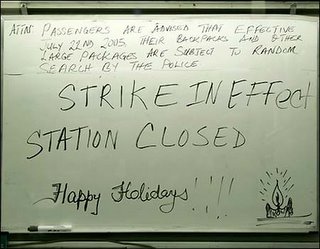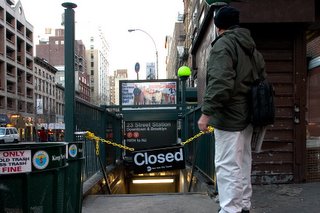MTA Strike Day 2

On Interstate 95 between Philadelphia and Trenton, signs warned northbound drivers: "AVOID NEW YORK CITY... MAJOR RESTRICTIONS."

At one subway booth, a handwritten sign read, "Strike in Effect. Station Closed. Happy Holidays!!!!"
At Penn Station — a major hub for commuter trains coming in and out of New Jersey and for Amtrak — an announcement over the loudspeaker told people to "please exit the subway system."
For a city that thrives on speed and convenience, tourists and shoppers, hustle and bustle, there could hardly be a worse time for a transit strike than five days before Christmas.New Yorkers (and let's not forget the 1000's travelling from NJ) faced another bone-chilling commute Wednesday without their cherished subways and buses as a transit strike entered its second day. The mayor, had earlier, put into effect a sweeping emergency plan,to reduce gridlock and keep certain streets open for emergency vehicles.
It included requiring cars coming into Manhattan below 96th Street to have at least four occupants until 11 a.m.
Police officers were checking each car and refusing to let those with fewer than four passengers continue into the heart of the city; some drivers were picking up random people off the street to meet the quota. However, vehicles traveling within Manhattan don't need to have four passengers.
Travelers crammed into Penn Station and Grand Central Terminal and jammed highways last night trying to leave the city. The evening commute was as frigid and spirited as, though perhaps more angry than, it had been in the morning, when even Mayor Michael Bloomberg walked over the Brooklyn Bridge to get to work.In the morning, traffic at the Lincoln and Holland Tunnels from New Jersey was about half the usual volume, and some Manhattan streets seemed more civilized than usual for rush hour.The LIRR, which is not on strike, added extra trains and shuttles to help commuters from Queens and Brooklyn who normally take MTA buses and subways into Manhattan. Metro-North Railroad did the same for travelers from the Bronx.
Drivers, including taxi drivers, were required to h
 ave at least four passengers between 5 a.m. and 11 a.m. to get into most of Manhattan. People jumped into cars with strangers, and cabbies picked up extra passengers - often with no additional fare - just to meet the requirement.Two-dozen Santas from Brookstone's department store stood on the bridge to greet commuters as they walked or biked across the bridge. Coffee and hot chocolate was also distributed to commuters there.
ave at least four passengers between 5 a.m. and 11 a.m. to get into most of Manhattan. People jumped into cars with strangers, and cabbies picked up extra passengers - often with no additional fare - just to meet the requirement.Two-dozen Santas from Brookstone's department store stood on the bridge to greet commuters as they walked or biked across the bridge. Coffee and hot chocolate was also distributed to commuters there.According to a CBS news report, the strike could cost as much as $400 million a day because the city is packed with tourists and this is always the busiest time of year at some of the most famous addresses in America — shops on Fifth Avenue and the theatres on Broadway. New York retailers, restaurants and bars are expected to bear much of the brunt of the strike. The week before Christmas traditionally accounts for up to 20 percent of many stores' holiday sales, and consumers who must pay higher taxi fares or face long walks could slow their spending.
Bloomberg, said not only is the city noticeably less busy than it is on a regular day, but many food delivery services have not been able to make their runs, schools opened two hours late, hotels were experiencing cancellations and airlines are "on edge."
Here are some of the KEY ISSUES FOR THE STRIKE.

0 Comments:
Post a Comment
<< Home